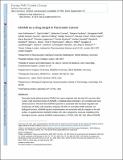| dc.contributor.author | Schlomann, Uwe | |
| dc.contributor.author | Koller, Garrit | |
| dc.contributor.author | Conrad, Catharina | |
| dc.contributor.author | Ferdous, Taheera | |
| dc.contributor.author | Golfi, Panagiota | |
| dc.contributor.author | Garcia, Adolfo Molejon | |
| dc.contributor.author | Höfling, Sabrina | |
| dc.contributor.author | Parsons, Maddy | |
| dc.contributor.author | Costa, Patricia | |
| dc.contributor.author | Soper, Robin | |
| dc.contributor.author | Bossard, Maud | |
| dc.contributor.author | Hagemann, Thorsten | |
| dc.contributor.author | Roshani, Rozita | |
| dc.contributor.author | Sewald, Norbert | |
| dc.contributor.author | Ketchem, Randal R. | |
| dc.contributor.author | Moss, Marcia L. | |
| dc.contributor.author | Rasmussen, Fred H. | |
| dc.contributor.author | Tuveson, David A. | |
| dc.contributor.author | Nimsky, Christopher | |
| dc.contributor.author | Bartsch, Jörg W. | |
| dc.contributor.author | Miller, Miles Aaron | |
| dc.contributor.author | Lauffenburger, Douglas A | |
| dc.date.accessioned | 2017-02-15T16:14:44Z | |
| dc.date.available | 2017-02-15T16:14:44Z | |
| dc.date.issued | 2015-01 | |
| dc.date.submitted | 2014-02 | |
| dc.identifier.issn | 2041-1723 | |
| dc.identifier.uri | http://hdl.handle.net/1721.1/106940 | |
| dc.description.abstract | Pancreatic ductal adenocarcinoma (PDAC) has a grim prognosis with <5% survivors after 5 years. High expression levels of ADAM8, a metalloprotease disintegrin, are correlated with poor clinical outcome. We show that ADAM8 expression is associated with increased migration and invasiveness of PDAC cells caused by activation of ERK1/2 and higher MMP activities. For biological function, ADAM8 requires multimerization and associates with β1 integrin on the cell surface. A peptidomimetic ADAM8 inhibitor, BK-1361, designed by structural modelling of the disintegrin domain, prevents ADAM8 multimerization. In PDAC cells, BK-1361 affects ADAM8 function leading to reduced invasiveness, and less ERK1/2 and MMP activation. BK-1361 application in mice decreased tumour burden and metastasis of implanted pancreatic tumour cells and provides improved metrics of clinical symptoms and survival in a Kras[superscript G12D]-driven mouse model of PDAC. Thus, our data integrate ADAM8 in pancreatic cancer signalling and validate ADAM8 as a target for PDAC therapy. | en_US |
| dc.language.iso | en_US | |
| dc.publisher | Nature Publishing Group | en_US |
| dc.relation.isversionof | http://dx.doi.org/10.1038/ncomms7175 | en_US |
| dc.rights | Article is made available in accordance with the publisher's policy and may be subject to US copyright law. Please refer to the publisher's site for terms of use. | en_US |
| dc.source | PMC | en_US |
| dc.title | ADAM8 as a drug target in pancreatic cancer | en_US |
| dc.type | Article | en_US |
| dc.identifier.citation | Schlomann, Uwe et al. “ADAM8 as a Drug Target in Pancreatic Cancer.” Nature Communications 6 (2015): 6175. | en_US |
| dc.contributor.department | Massachusetts Institute of Technology. Department of Biological Engineering | en_US |
| dc.contributor.mitauthor | Miller, Miles Aaron | |
| dc.contributor.mitauthor | Lauffenburger, Douglas A | |
| dc.relation.journal | Nature Communications | en_US |
| dc.eprint.version | Author's final manuscript | en_US |
| dc.type.uri | http://purl.org/eprint/type/JournalArticle | en_US |
| eprint.status | http://purl.org/eprint/status/PeerReviewed | en_US |
| dspace.orderedauthors | Schlomann, Uwe; Koller, Garrit; Conrad, Catharina; Ferdous, Taheera; Golfi, Panagiota; Garcia, Adolfo Molejon; Höfling, Sabrina; Parsons, Maddy; Costa, Patricia; Soper, Robin; Bossard, Maud; Hagemann, Thorsten; Roshani, Rozita; Sewald, Norbert; Ketchem, Randal R.; Moss, Marcia L.; Rasmussen, Fred H.; Miller, Miles A.; Lauffenburger, Douglas A.; Tuveson, David A.; Nimsky, Christopher; Bartsch, Jörg W. | en_US |
| dspace.embargo.terms | N | en_US |
| mit.license | PUBLISHER_POLICY | en_US |
